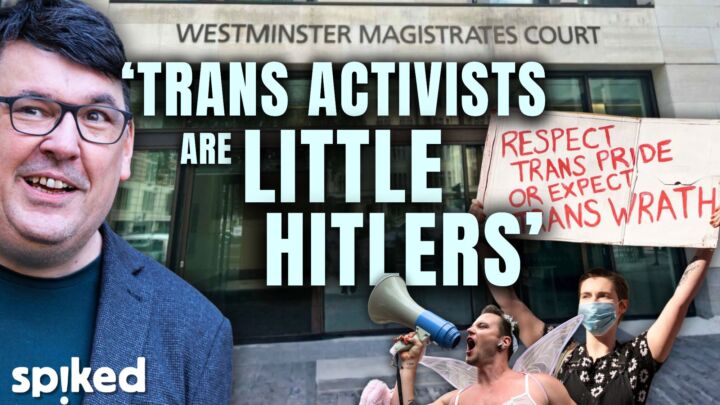The new Fourth Plinth is a monument to trans narcissism
Gender-identity ideology is quite literally being put on a pedestal in London’s Trafalgar Square.

Want unlimited, ad-free access? Become a spiked supporter.
The lump of art unveiled this week on the Fourth Plinth couldn’t be more revealing. For the next 18 months, visitors who pass through Trafalgar Square will be confronted by a cube of 726 pseudo-death masks of ‘trans and nonbinary’ people.
Each of the casts, moulded from volunteers in the UK and Mexico, face inward towards a void in the middle of the work. This perfectly encapsulates the vacuous narcissism of the trans movement, not to mention the stupidity of the establishment figures who prop it up with obscene amounts of taxpayer cash. In selecting this work, the fourth plinth judging panel has put a spurious cause quite literally on a pedestal.
This was by no means the intended message. Mexican artist Teresa Margolles created the piece, titled Mil Veces un Instante, to commemorate Karla La Borrada. La Borrada was a trans-identified singer and male prostitute who, like many in Mexico’s sex industry, was tragically killed. Margolles uses her art to highlight the vulnerability of what she terms ‘the trans community’, a cause that arguably has more relevance to those selling sex on the streets of Mexico than to, say, whining nonbinary brats at British universities.
The facts and figures underpinning claims about the vulnerability of the ‘trans community’ deserve scrutiny. From 2022 to 2023, an estimated 320 people thought to be trans were murdered across the world, 52 of whom were in Mexico. Where the victim’s occupation was known, 48 per cent were involved in the sex industry. Their untimely deaths are undeniably tragedies that will be mourned by loved ones. But they are not evidence of an epidemic of anti-trans hatred. They are evidence that the sex industry is dangerous.
Sadly, campaigning to stop men’s abuse of prostitutes isn’t as on-trend as complaining about ‘transphobic’ violence. Listen to your average British trans activist and it is TERFs (trans-exclusionary radical feminists) like me who are supposedly responsible for a ‘genocide’ because we refuse to use she / her pronouns – rather than the dangerous men who are actually maiming and murdering prostituted people.
Of course, according to the woke values of the British art establishment, this new installation ticks every box – the masks are, after all, of brown, poor, transgender sex workers. What judging panel could ask for more? Yet art that is chosen to further the patron’s preferred politics is sucked dry by the process. Granting awards and exhibition opportunities according to the right diversity criteria is the multimillion-pound equivalent of painting by numbers.
Margolles offers something else the elites think is juicy, too – a tiresome, boundary-pushing edginess that has become a substitute for talent. As a pioneer of ‘corpse art’, Margolles’s studio in Mexico City adjoins a morgue. She even boasts of using fluids from the dead bodies brought in.
Artists have always pushed boundaries and lived on the edges of acceptability. Every work that’s been placed on the plinth since it first began to feature artworks in 1999 has provoked outrage. Any piece that didn’t could be said to have failed.
When artist Mark Quinn, who has used his own blood to create artworks, was chosen for the Fourth Plinth in 2005, some critics were scathing. Yet Quinn’s 3.5-metre marble sculpture of disabled artist Alison Lapper achieved something rare and precious in modern art. It broke social boundaries and changed the conversation around disability. And that’s because it represented something worth celebrating. The sculpture, entitled Alison Lapper Pregnant, showed what he termed ‘a different type of heroism’. It was a bold and proud representation of disability and motherhood. This was a genuinely celebratory work, a beautiful public piece of art that spoke of hope and overcoming real barriers.
By contrast, the choice of Margolles’s ghoulish monument to an overhyped threat points to a moribund future where shock triumphs over substance. In this, it is perhaps best understood not as a memorial to a murdered Mexican male prostitute, but rather as a memorial to the butchered British arts.
Jo Bartosch is a journalist campaigning for the rights of women and girls.
Picture by: Getty.
You’ve read 3 free articles this month.
Support spiked and get unlimited access.
Help us hit our 1% target
spiked is funded by readers like you. It’s your generosity that keeps us fearless and independent.
Only 0.1% of our regular readers currently support spiked. If just 1% gave, we could grow our team – and step up the fight for free speech and democracy right when it matters most.
Join today from £5/month (£50/year) and get unlimited, ad-free access, bonus content, exclusive events and more – all while helping to keep spiked saying the unsayable.
Monthly support makes the biggest difference. Thank you.









Comments
Want to join the conversation?
Only spiked supporters and patrons, who donate regularly to us, can comment on our articles.